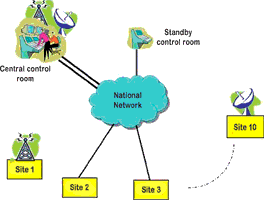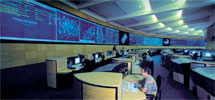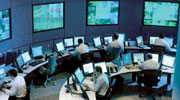
The so-called convergence trend taking place in the security and safety industry brings with it some exciting possibilities in terms of wide area management of sites and facilities, particularly in terms of central monitoring for safety and security applications.
Data transmission bandwidth costs have reduced and more networking connectivity options are available with greater reliability. The cost of a connection can be the same for a local or national session. This makes it feasible to monitor national sites from a central location including live video from multiple cameras. Furthermore, emerging integration software platforms are capable of communicating with a variety of third party sub-systems so that each of the sites or facilities does not have to have the same equipment.
Consider a government organisation or commercial enterprise with many facilities nationwide. It may not be economically feasible to build, and more importantly staff, as many control rooms as there are facilities. In particular, the issue of having a hot site standby control room in the event of a system failure must be considered. A single control room with a back-up site able to monitor all of the facilities nationwide may well be economically justifiable. Certainly it will be cheaper, even taking into account the cost of communications. The diagram depicts the concept.

The standby control room, which should be in a different location from the central one, should provide a mirror imaged backup of all recorded surveillance and audit trail material, but can also be there as a secondary, fully functional or skeleton backup control room. Note the principle of multiple wide bandwidth links.
One of the more expensive components in a control room can be the central monitoring software. A decent video wall also makes a control room more efficient and allows operators to work collaboratively. Having a single central site would enable the organisation to invest in making the control room more effective. Examples of control rooms with video walls are shown below. The very impressive Telkom control room in the top image has a video wall over 100 m long! The image on the bottom is of Canary Wharf in London.


The following central monitoring functionality are examples of those that can readily benefit from being handled centrally with even limited bandwidth:
* Alarm verification - intrusion alarms, perimeter fence alarms and equipment health technical alarms can all be monitored centrally using video surveillance verification on alarms being received.
* Access control to remote sites - unmanned sites such as communications stations or high risk on entry sites such as bank branches can have access controlled for the first person entry on request with video verification.
* Personnel tracking - this relatively new function is made possible by modern ultra-compact global positioning and cellular phone technology in that small personal devices combining the two technologies are available for central monitoring of staff whereabouts or staff under duress situations.
Given more capital outlay, operators and communication bandwidth considerably more functionality can be achieved centrally, including:
* Live surveillance - premises, access routes and perimeters where there is constant traffic can be monitored for suspicious situations.
* Facilities management - the possibility of continuous monitoring makes it feasible to manage facilities in terms of parking and lighting.
* Business process monitoring - business intelligence software introduces the concept of software dashboards for process monitoring that, in addition to enterprise management having access to the data when necessary, could also be monitored for sudden changes in 'realtime' by trained operators.
Another technology that makes central monitoring easier to manage is that of video analytics for behavioural analysis - the ability to detect loitering, fighting, graffiti writing and left packages. Other possibilities using video analytics are those of crowd management - automatically monitoring for congestion, overcrowding and queue build up. Anything that makes an operator's task simpler and less prone to human error is an advantage.
Nationwide central monitoring is no longer the domain of communications network monitoring or vehicle tracking - it is now in the realms of all government and commercial operations with national footprints requiring facilities safety and security monitoring.
For more information contact i to i technologies, +27 (0)31 562 9535, [email protected], www.itoitechnologies.com

© Technews Publishing (Pty) Ltd. | All Rights Reserved.